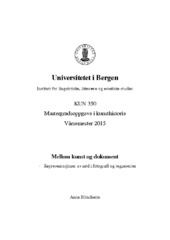| dc.description.abstract | Denne oppgaven diskuterer representasjonen av nød gjennom fotografi og tegneserier. Jonas Bendiksens prosjekt, Steder der vi bor og Andrea Gjestvangs prosjekt En dag i historien - 22. juli er begge fotografiske prosjekter som består av portretter av mennesker i vanskelige situasjoner og begge bruker tekst for å forankre konteksten nødvendig for en forståelse, men de skiller seg fra hverandre ved at mens Bendiksens prosjekt omhandler slummer i tredje verden, skildrer Gjestvangs prosjekt norske ungdommer som overlevde massakren på Utøya i 2011. De fordrer derfor en diskusjon om resepsjonen av den nøden som rammer nært og den nøden som rammer fjernt. Joe Sacco bruker sin journalistiske bakgrunn til å skildre Gazas trøblete historie i tegneserieform. I Footnotes in Gaza undersøker to massakrer som ble begått i Khan Younis og i Rafah i 1956. Denne tegneserieboken settes opp mot Art Spiegelmans tegneseriebok Maus. I sistnevnte forteller Spiegelman om sin far opplevelser i Auschwitch og sin egen historie ved å vokse opp under dette traumet han selv ikke var en del av. Mens Sacco har en viss distanse fra traumet er det dypt personlig for Spiegelman. Et annet skille mellom disse tegneseriebøkene er at mens Holocaust er grundig dokumentert og skrevet inn i verdenshistorien, er overgrepene i Gaza udokumentert og dermed forvist til fotnotene. Dette fremmer et spørsmål om tillit: Kan tegneserien fungere som et dokument på noe virkelig? Fotografiet har et visst objektivt preg. Dette har vært skriver Roland Barthes. Denne indeksikaliteten er ikke til stede i en tegning, men som postmodernistisk fototeori påpeker, fotografen gjør et utvalg i hva som kommer innenfor billedflaten og redaktøren gjør et valg om hva som kommer på trykk. Dette er begge subjektive valg. Fotografier er et produkt av kulturen som har skapt det og det er avhengig av en tekstlig forankring for å gi den nødvendige konteksten for å kunne tolkes. Så er egentlig en tegneserie så mye mer subjektiv enn en fotoserie med tekst? Vi gir fotografen tilliten om at han/hun forteller noe sant, på samme måte som vi må stole på tegneserieskaperen. I den samtidsdokumentarfotografiske teorien blir det sagt at dokumentarfotografiet av grusomheter er i krise. Denne krisen baserer seg på en videreføring av postmodernistenes kritikk fra 1960- og 1970-tallet. Behovet for kontekst, etiske problemstillinger og tilliten til fotografen. Kan fotografiet formidle det vi trenger å vite om begivenhetene? Alle representasjoner av lidelse forholder seg til denne krisen og har utviklet en form for strategi som svar på den, inkludert mine eksempler. Avslutningsvis undersøker jeg disse strategiene. | en_US |
| dc.description.abstract | This thesis discusses the way documentary photographs and documentary comic books can represent suffering. The Norwegian photographer Jonas Bendiksen's project The Places We Live and photographer Andrea Gjestvang's project One Day in History - 22. July are both based on portraits of people in difficult life situations, but they differ when it comes to our, the Northern world's, distance to the trauma exhibited. While Bendiksen depicts slum environments in the Third World, Gjestvang portrays Norwegian survivors of the Utøya massacre in 2011. In other words, they endorse the discussion around the suffering that is close to us and the suffering of the other, far away. Joe Sacco uses his journalistic background to dive into the past of Gaza. The graphic novel Footnotes in Gaza, is based on two massacres in Khan Younis and Rafah around 1956. This book is put up against Art Spiegelman's graphic novel Maus is a memoir of his own life growing up in the shadow of two Holocaust survivors, and the tale of his father's life from before the war and through his time spent in Auschwitch to the liberation. While Sacco has a distance to the trauma he represent, it is deeply personal for Spiegelman. Another difference between these comic projects is that while the Holocaust is well documented and written into our public history, the massacres in Gaza are not. This raises the issue of trust. Can we rely on a comic book as a source of something true? Photography has a certain objective aspect to it. It must have been, says Roland Barthes. This indexicality is not present in a drawing, but, as postmodern theorists of photography have argued, the photograph also is a matter of subjective choice of the photographer and the editor. It is a part of a cultural visual language and it need written material to give it the context needed for reading it. Is the comic book actually that more subjective than the photograph with additional added texts? We trust the photographer to tell the truth, just as much as we trust the comic book maker to do so. In contemporary documentary photograph theory it has been argued that the documentary photography of atrocities is in a crisis. This crisis is based on the same critique the postmodern theorists put forward in the 1970s and the 1980s. The need for context, ethical issues and the trustworthiness of the photographer. Can the photograph tell us what we need to know? All projects dealing with atrocities, including my own cases, have found some sort of strategy for communicating them for an audience. The final part of this thesis discusses these strategies. | en_US |
